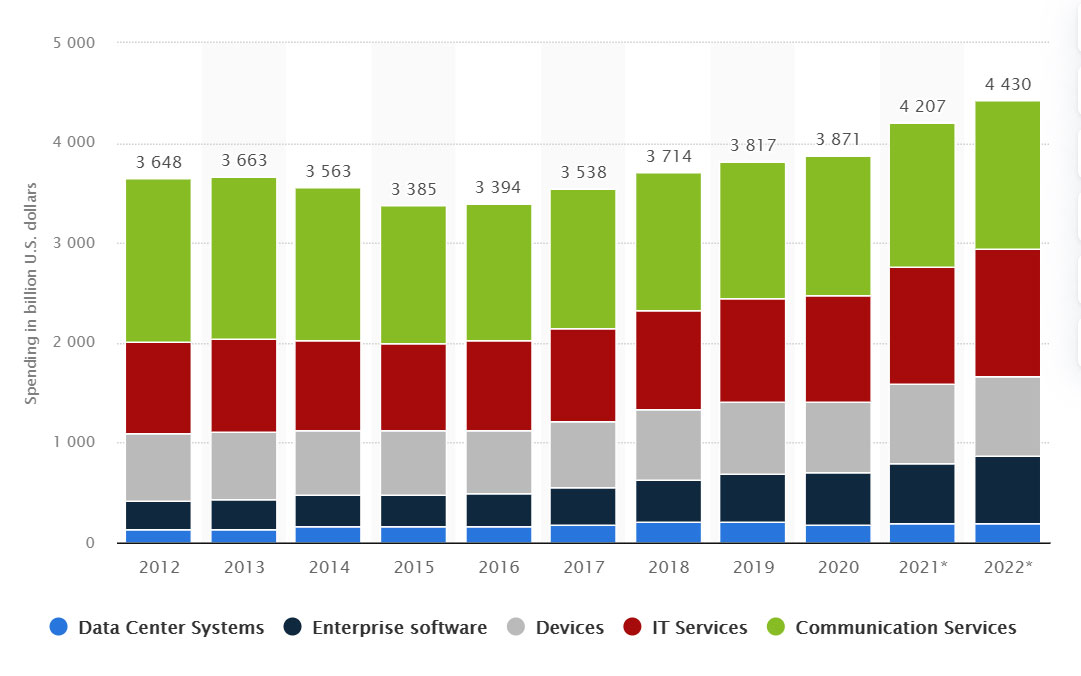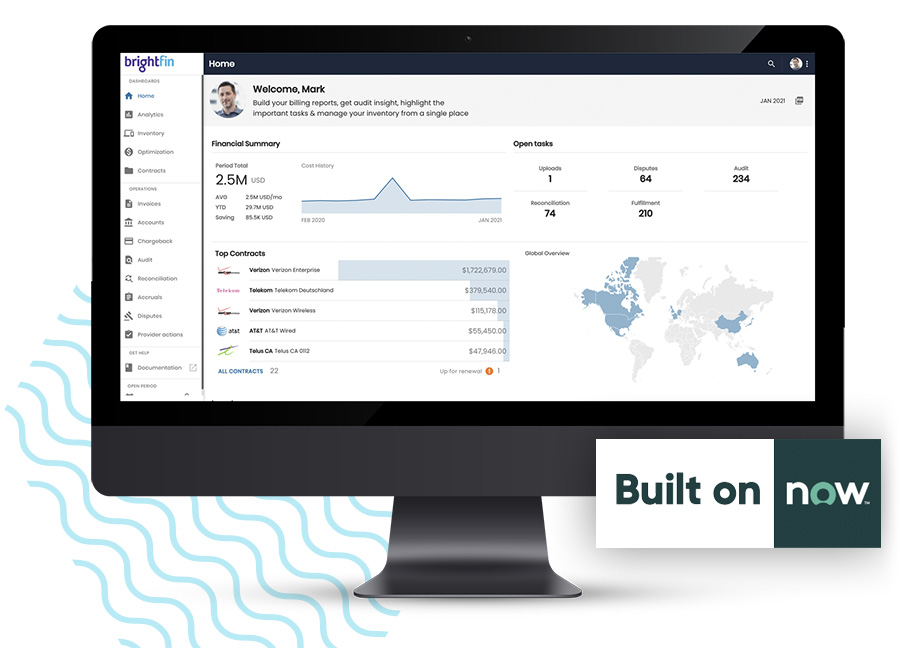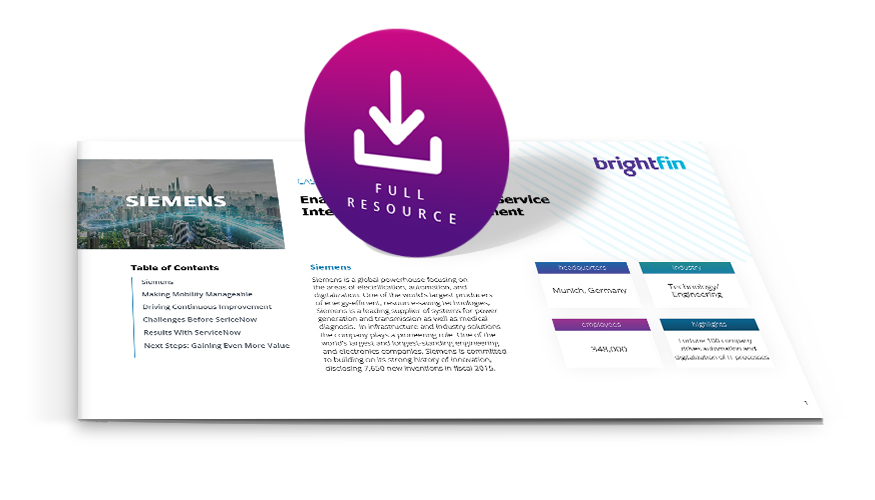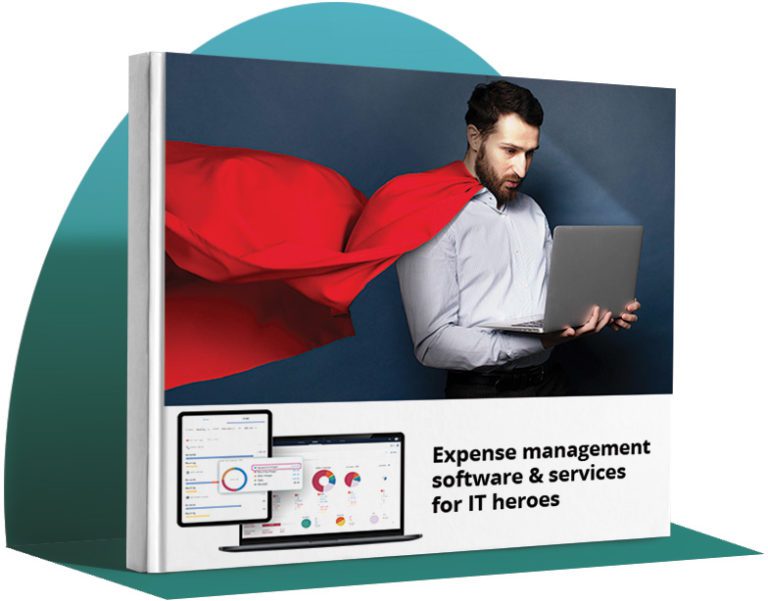Introduction to IT transformation trends
According to Gartner, “Worldwide IT spending is projected to total $4.1 trillion in 2021, an increase of 8.4% from 2020.” And the trends all point toward more growth as technologies like IoT, 5G, Machine Learning, and AI become more prevalent.
For organizations in an increasingly digital and competitive market, this means they must take steps to keep pace with industry peers. Enterprises need to not only optimize existing systems but also look for new applications and services that generate deeper insights into their business. Gone are the days where IT should be seen as a reactive, inflexible organization.
IT spending graph from Statista

This is where IT transformation comes in. TechTarget defines IT transformation as “a complete reassessment and overhaul of an organization’s information technology (IT) systems in order to improve the efficiency and delivery in a digital economy. IT transformation forms the foundation of an organization’s larger digital transformation strategy and is led by business leaders, such as the CIO. It can involve changes to — and modernization of — network architecture, hardware, software, IT service management, and how data is stored and accessed. Informally, IT transformation may be referred to as “rip and replace.”
For those organizations not born in the digital age, a complete rip and replace all existing IT systems is often prohibitively expensive and disruptive to the business. As a result, these organizations must balance the needs of legacy applications, systems, and business models that are often a huge resource drain. The ongoing explosion of connected devices means that a patchwork approach to IT is no longer a viable option.
But, in order to develop robust transformation strategies, CIOs and IT leaders need insight and analytics into IT expenses. Gaining a clear insight of the organization’s existing assets and expenses is a critical first step in communicating IT’s value to the CFO.
Below, we’ll cover top challenges and key benefits of IT transformation as well as 8 critical steps that IT leaders need to be considering.
Top 4 challenges of IT transformation:
#1: Updating legacy IT systems and processes
According to CIOReview, 80% of the IT industry is still running critical services on traditional infrastructures. These old systems are often expensive to maintain and clunky to operate.
Even still, for many organizations, the cost of maintaining old systems is quickly outpacing the cost of upgrading. Without the right expertise, a transition to the cloud is a daunting experience. If your organization is planning an update of old systems and processes, we’ve put together a webinar covering the top 6 steps to effectively transforming your network.
Check out the free webinar here: Join a live session or watch a replay of a past webinar to review the six steps to an effective network transformation.
#2: Improving the end-user experience
Especially in the past couple of years, organizations have learned the need to adapt their networks to accommodate work from anywhere. This means IT has to balance increasingly complex networks and digital use cases just to meet the needs of their end-users. This combined with the pressure to keep pace with or surpass the competition creates urgency around IT transformation and business innovation.
Employees expect technology that’s intuitive and easy to use; often on par with the technology they use in their personal lives. But legacy network architectures can slow productivity and require a lot of work to update. If you want to get the most out of your people, it is critical to consider your end-users and how IT can support empowering the human experience.
#3: Implementing new operating models
Along with the challenges of obsolete technology and evolving end-user needs, IT leaders must also address outdated behaviors and practices. We all know how hard it is to implement change, this is only amplified in large organizations with distributed workforces.
Any transformation of the current business model obviously requires changes. There are many reasons why people in the organization may be reluctant to change. An inability to manage change is one of the key aspects that can cause the implementation of new processes to fail. Transparency, empathy, communication, and personalized responses are essential to overcome this scenario.
Updating your IT infrastructure means thinking about the people and processes who will be using the new solutions. IT should work with each department in selecting the right technologies for their specific needs. This practice often simplifies implementation and maintenance and increases end-user adoption.
#4: Securing data across the organization
According to IBM, 2021 has seen Data breach costs rise from USD 3.86 million to USD 4.24 million, the highest average total cost in the 17-year history of this report.
A distributed workforce and more connected devices mean a larger edge of attack. Something as simple as enforcing a passcode on devices can have a huge impact. In fact, the most common initial attack vector, compromised credentials, was responsible for 20% of breaches at an average breach cost of USD 4.37 million.
All it takes is a single employee to compromise your network. You might think it is common sense to make good decisions with regard to app usage, cybersecurity threats, and other malicious software, but the reality is that most end users are simply unaware. Performing regular training will help keep your data safe as well as ensuring your non-IT staff is up to date on corporate security policies.
4 Key benefits of IT transformation
#1: Data-driven decision making
The ongoing revolution of big data means that businesses can now access huge amounts of data points. However, without the right tools, it can be hard to automate and make sense of all that data. IT transformation supported by leading IT expense technology means these large volumes of data can be processed into useful business insights that can help to speed up decision-making processes. By attaching key metrics to IT assets by location and department, an organization can evaluate its entire technology landscape.

CIOs and IT leaders with the right data can create a business case to justify increased IT budget requests. Finance will surely ask the tough questions like, “which region is spending the most on IT?” or “at this location, which assets do we own and how many contracts are active?” By getting full visibility across all of your IT spend in one platform, you’ll be in a better position to justify IT costs across the business and ask for the necessary budget to support future growth. Talk the language of the business – knowing your numbers will allow you to tie increased expenses to business growth goals.
#2: Create a better customer experience
At the end of the day, the main objective is to use newer and modern technological innovations to create a better customer experience.
Regardless of the industry, customers always demand value for their investment. What’s more, they usually want it as quickly as possible. It’s probably no surprise then that when asked about their decision to implement a digital transformation strategy, nearly half of all organizations listed customer experience and customer satisfaction as their primary influence.
Companies that effectively enable IT transformation are creating highly engaged customers. Research shows that these customers are:
- 6x more likely to try a new product or service from their preferred brand
- 4x more likely to have referred your brand to their friends, family and connections
- 2x more likely to make a purchase with their preferred brand, even when a competitor has a better product or price
#3: Encourage collaboration across departments
Enterprise-wide success relies on a variety of departments each delivering value in unique ways. Through successful IT transformation, the employees from different departments in an organization will be able to communicate quickly and learn together.
By building a solid foundational infrastructure on which to deliver automated services, cloud computing and new operating models, IT leaders can help pave the way for better collaboration across the business. This can also have the effect of automating and accelerating the deployment of IT services while reducing risk during deployments. IT transformation enables delivering IT as a service that is more cost-effective, agile and helps foster innovation.
Additionally, IT transformation often allows optimizing traditional IT cost models, meaning organizations free up IT budget from operational expenses and can allocate more funds for digital transformation. Ultimately, IT transformation ensures better business-IT alignment.
#4: Happier / more productive people
More and more, organizations are realizing that employees are more productive when they’re happy. During Oxford’s extensive study into happiness and productivity, they found that workers are 13% more productive when happy.
And while CIOs and IT leaders may not have complete control here, they are still responsible for providing the tools and technology that connect employees to the overall mission of the organization. This is where successful IT transformation can help deliver huge results. IT strategies that are connected to core business objectives can provide substantial solutions to finance and human resources.
When done properly, IT is able to bridge digital and process transformation to earn a seat at the business table. By aligning all of IT’s efforts with the impact it has across the organization, CIOs will be able to empower end-users with the tools and technology they need to do their jobs effectively. The opportunity here is for IT to take a proactive approach where technology-led innovation becomes a critical part of overall business strategy.
![]()
How SIEMENS is driving continuous improvement
Siemens is driving simplicity from an end-user perspective while improving process efficiency and reducing costs, helping the company accelerate its digital transformation. Now Siemens can:
- Simplify service management with a one-stop-shop portal (myIT) for end-users
- Improve IT service quality and time to market while having end-to-end accountability in place
- Provide full visibility into mobile assets, plans, and features
- Track usage and expenses to reduce overall costs and wasteful spending
- Automate interfaces to easily plug in and out providers
“ServiceNow and brightfin is our speed dial for digitalization,” says Egelhaaf. “It puts IT into the position to provide better support and generate more value for the business.”
Click here to download the full PDF.
Your 8-Step IT Transformation Guide
#1: Start with the end-state in mind
As with any organizational change, IT transformation must begin with an effective strategy if it is to be successful. This starts with creating a clear vision of the future state of IT and the business case for transforming IT. The input and sponsorship of senior management is critical here. Business and IT leaders must define the foundational needs, scope and scale of the IT transformation project, including developing a clear project timeline
Ask yourself:
- Who are our sponsors across each department and in the leadership team?
- What are the expected outcomes of a successful IT transformation for the business?
- What KPIs and business intelligence do we need to measure this success?
#2: Structure the relationship between IT and the rest of the business
There needs to be a clear definition of the relationship between IT and the rest of the organization, with a detailed layout of the business and IT decision-making requirements. With such a framework, it is much simpler to develop the strategies that allow every department to succeed. It is often simplest if this stage is supervised by a single, delegated senior IT executive.
#3: Outline existing IT systems and assets
Now that we understand what the end goal is, and how this relates to each department, you must gain a detailed understanding of existing IT systems and assets. Here, the scope and scale of the IT transformation should be thoroughly defined. Make sure you have a tool that allows you to see technology assets across the organization by department or strategic initiative. It is critical to have an actual understanding of necessary upgrades to your network.
#4: Develop a detailed network transformation strategy
70% of companies fail with their network transformations due to poor planning or execution. Begin by asking yourself some critical questions:
- Are your current network limitations impacting revenue?
- Are you looking for ways to optimize technology usage while reducing costs?
These are valid reasons to look at core infrastructure and will become the foundation of the business case which will drive your network transformation.
Check out the free webinar here: Join a live session or watch a replay of a past webinar to review the six steps to an effective network transformation.
#5: Invest in people and change management
Your IT needs and business use cases are likely to be as unique as your organization itself. Whether it is a dozen connected devices monitoring the health of patients, a construction site, or anywhere else, IT transformation requires a tremendous variety of knowledge and skills to effectively pull off. CIOs and business leaders need to ensure the right talents are assigned the appropriate responsibilities. Whether it is security, telecom administration, customer support, or product development, consider the ways technology can help improve the human experience. The ability to manage the motivation and morale of every individual affected by the IT transformation may seem daunting, but it will pay dividends if you consider the impact. It is vital that you share the bigger picture and vision of the organization with all members of the staff. This is where the ever-popular buzzword “culture” overlaps with IT.
#6: Understand the role of partners and vendors
Likely, your IT team already relies on a variety of vendors to help them deliver services. Therefore, every transformation requires a solid vendor management system. You should evaluate the contributions of all partners and vendors in the scope and progress of your IT transformation. This will also inform you if there are any gaps in your current vendor and partner structure.
#7: Manage risks and security
Look for a robust Unified Endpoint Management solution that delivers a zero-trust strategy. End-user devices present points of weakness into networks. An effective endpoint security strategy serves to protect networks from unauthorized intrusion and risky user practices. While a zero-trust approach to network security will help ensure that should an unauthorized intrusion occur, they won’t have access to every part of the network.
#8: Create an agile implementation plan… and start executing
It’s a common adage that the one constant is change. That’s why the methodology employed in the implementation of IT transformation is so important. With that in mind, your implementation plan should be prepared to manage change throughout the process. This is where having the end state in mind from the very beginning will help ensure you have guideposts throughout the IT transformation process. Carrying out swift test-and-learn cycles on new technologies and processes in isolated instances can help you understand the best ways to roll those strategies out at scale.










